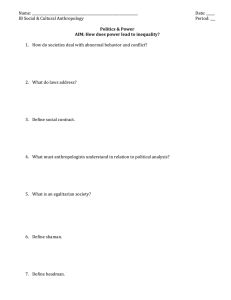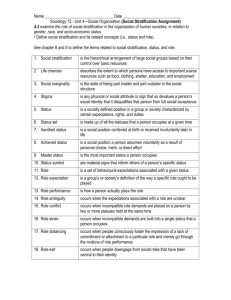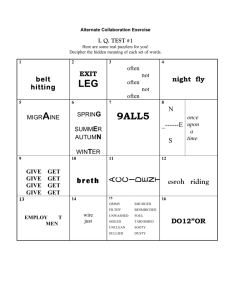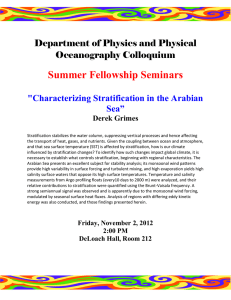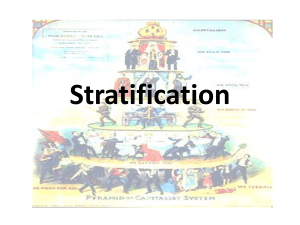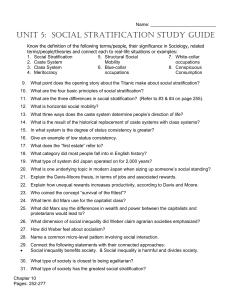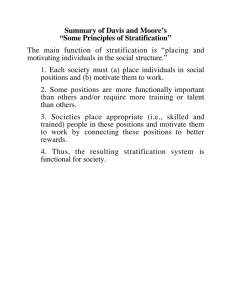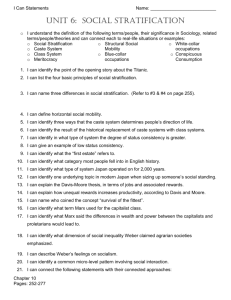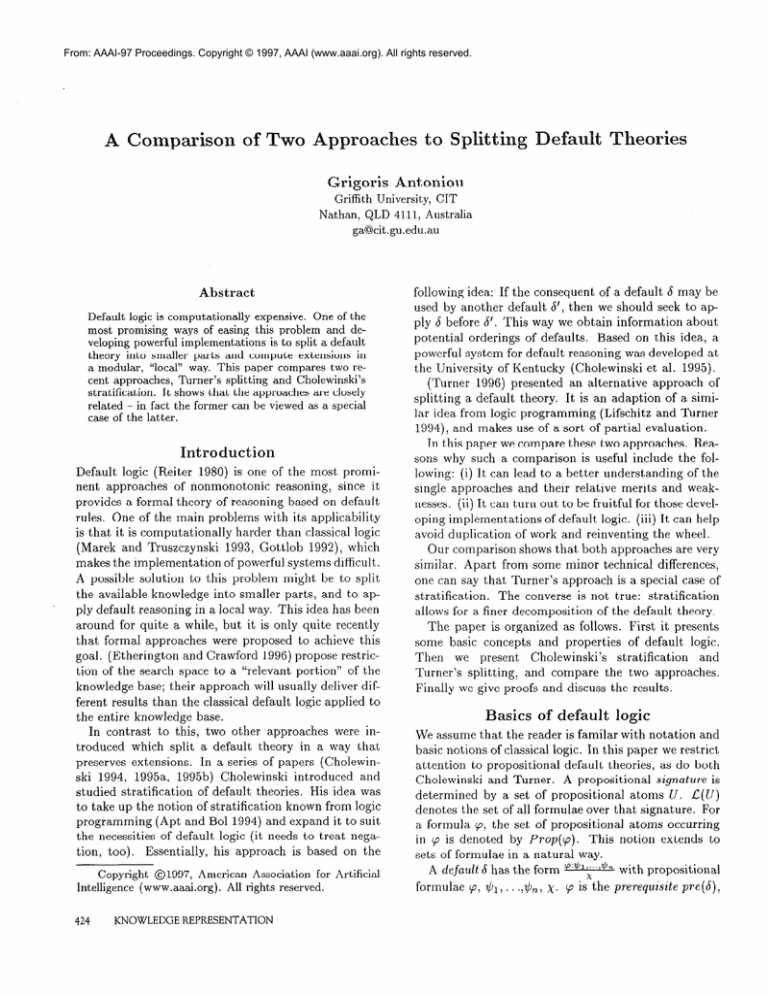
From: AAAI-97 Proceedings. Copyright © 1997, AAAI (www.aaai.org). All rights reserved.
Grigoris
Pant
Griffith
Nathan,
University,
QLD
4111,
ga@cit.gu.edu.au
Abstract
Default
logic is computationally
expensive.
One of the
most
promising
ways
of easing
this problem
and developing
powerful
implementations
is to split a default
theory
into smaller
parts
and compute
extensions
in
a modular,
“local”
way.
This
paper
compares
two recent approaches,
Turner’s
splitting
and Cholewinski’s
stratification.
It shows
that the approaches
are closely
related
- in fact the former
can be viewed
as a special
case of the latter.
Introduction
Default
logic (Reiter
1980) is one of the most prominent approaches
of nonmonotonic
reasoning,
since it
provides a formal theory of reasoning
based on default
rules. One of the main problems
with
its applicability
is that it is computationally
harder than classical logic
(Marek
and Truszczynski
1993, Gottlob
1992), which
makes the implementation
of powerful systems difficult.
A possible solution
to this problem
might be to split
the available
knowledge
into smaller parts, and to apply default reasoning
in a local way. This idea has been
around for quite a while, but it is only quite recently
that formal approaches
were proposed
to achieve this
goal. (Etherington
and Crawford
1996) propose restriction of the search space to a “relevant
portion”
of the
knowledge
base; their approach
will usually deliver different results than the classical default logic applied to
the entire knowledge
base.
In contrast
to this, two other approaches
were introduced
which
split
a default
theory
in
a way
that
preserves extensions.
In a series of papers (Cholewinski 1994, 1995a, 1995b) Cholewinski
introduced
and
studied
stratification
of default
theories.
His
idea
was
to take up the notion of stratification
known from logic
programming
(Apt and Bol 1994) and expand it to suit
the necessities of default logic (it needs to treat negation, too).
Essentially,
his approach
is based on the
Copyright
Intelligence
424
01997,
(www.aaai.org).
KNOWLEDGE
American
All
REPRESENTATION
Association
for
rights
reserved.
Artificial
OlliOU
CIT
Australia
following
idea: If the consequent
of a default S may be
used by another
default S’, then we should seek to apply S before S’. This way we obtain information
about
potential
orderings
of defaults.
Based on this idea, a
powerful
system for default reasoning
was developed
at
the University
of Kentucky
(Cholewinski
et al. 1995).
(Turner
1996) presented
an alternative
approach
of
splitting
a default theory.
It is an adaption
of a similar idea from
logic
1994),
and makes
programming
use of a sort
(Lifschitz
of partial
and Turner
evaluation.
In this paper we compare these two approaches.
Reasons why such a comparison
is useful include the following:
(i) It can lead to a better understanding
of the
single approaches
and their relative
merits and weaknesses. (ii) It can turn out to be fruitful
for those developing implementations
of default, logic. (iii) It can help
avoid duplication
of work and reinventing
the wheel.
Our comparison
shows that both approaches
are very
similar.
Apart from some minor technical
differences,
one can say that Turner’s
approach
is a special case of
stratification.
The converse is not true: stratification
allows for a finer decomposition
of the default theory.
The paper is organized
as follows.
First it presents
some basic concepts
and properties
of default
logic.
Then
we present
Cholewinski’s
stratification
and
Turner’s
splitting,
and compare
the two approaches.
Finally
we give proofs and discuss the results.
Basics
of default
logic
We assume that the reader is familar with notation
and
basic notions of classical logic. In this paper we restrict
attention
to propositional
default theories,
as do both
Cholewinski
and Turner.
A propositional
signature
is
determined
by a set of propositional
atoms U. L(U)
denotes the set of all formulae
over that signature.
For
a formula
‘p, the set of propositional
atoms occurring
in cp is denoted
by Prop(p).
This notion
extends to
sets of formulae
in a natural
way.
A default S has the form ylql ;l’Z1/l” with propositional
formulae
cp, $Q, . . .,gn, x. cp is the prerequisite
pre(S),
+n the justifications
just(J),
and x the consequent cons(S) of S. A default theory T is a pair (IV, 0)
consisting
of a set of formulae
W (the set of facts) and
a countable
set D of defaults.
In case D is finite and
W is finitely
axiomatizable,
we call the default theory
T = (W, D) finite. In this paper we will be mostly concerned with finite default theories.
This is acceptable
from the practical
view, of course.
Sometimes
it is technically
convenient
to treat facts
as defaults.
A fact v can be represented
by the associated default def(cp) = y.
Thus, a default theory
T = (W, D) can be represented
by the set of defaults
D’ = def(W)
U
D.
Let S = ~‘@l;~~~lL” be a default, and E a deductively
closed set of formulae.
We say that S is applicable to E
iffcpEE,andl$1,...,
llCln@E.
Let T = (W, D) b e a default
theory
and II =
or infinite
sequence of defaults
(Jo,
61,
&,
. . .) a finite
from D without
multiple
occurrences
(modelling
an application
order of defaults from D). We denote by II[k]
the initial segment of II of length k, provided
the length
of II is at least k.
e In(II)
= Th(W
0 Out(II)
= {-J
U {cons(d)
1 $ E just(~),~
16
occurs
occurs
in II})“.
justification
+ of a default
c, II is closed iff every
In (II) already occurs
default
in II.
in II is consistent
that
is applicable
with
to
The default theories T = (W, D) and
U D) h uve the same extensions.
Stratification
Let D be a finite set of defaults.
A function
p assigning
a natural number to every default from D is a strutificution function, iff for any defaults S, 6’ E D the following
condition
holds:
2where
Th(lM)
A! of formulae.
the context we
In
d enotes
the deductive
case the signature
write Thv( M).
closure
U is not
consider
the following
61 = true:P,J=P:q
~
P
(Antoniou
1997) shows that Reiter’s original
definition
of extensions
is equivalent
to the following
one: A set
of formulae
E is an extension of a default theory T iff
there is a closed and successful process II of T such
that E = In(II).
F inally we formulate
a simple result
which will be used later.
%heorem 2.1
T’ = (8, def(W)
Theorem
3.1 Let T = (W, D) be a stratified default theory, p an associated stratification function, and
LA,. . . , DI, the decomposition of D into strata. Then
E is a consistent extension of T iff for all 0 5 i 5 k
there exists Ei such that Ek = E, Eo = Th(W), and
for all 1 5 i 5 k, Ei is a consistent extension of
Ti = (Ei-1, Di). Sometimes we say that E is generated by p.
to
In@).
p(S) 5 ~(6’)~.
a number to each default, p decomposes
(strata)
D1, . . . , Dk of ascending
value
denote by Strutum,=k(D)
the stratum
p(S) = k for all 6 E Di. A default theD) is called stratified iff W is consisent,
Prop(W) II Prop(cons(D) U just(D))
= 8, and there
exists a stratification
function
for D.
Essentially,
this definition
follows the idea that in
case the information
provided
by the default S may be
used by the default S’, we should seek to apply S before
S’. The following
result from (Cholewinski
1994) shows
that decomposition
of a set of defaults
according
to a
stratification
function
preserves the extensions.
For example,
o II is successful iff In(B)
II O&(B)
= 0, otherwise
it is failed. Note that in case II is successful, every
# 0 then
By assigning
D into layers
under p. We
Di such that
ory T = (W,
in II}.
e II is called a process of T iff SI, is applicable
rn(II[k]),
for every k such that S,+ occurs in II.
n Prop(J’)
If Prop(cons(S))
Ih,*-7
J3=
defaults:
r:1pJ4./=ue:.
Q
‘P
S
According
to the definition
of a stratification
function,
62 and Ss make use of information
in the consequent
of
S1 and & (because of the propositional
atomp),
but not
vice versa. So, p(&) and ~(63) may be strictly
greater
than ~(61) and p(Sa), but certainly
not less. On the
ot,her hand, by definition,
~(61) must equal ~(64). Thus
one possible stratification
function
is:
p(&) = p(S4) = 1, P(S2)
This function
function
is
creates
two strata.
=
P&)
= 2.
Another
stratification
p’(S1) = p’(64) = 1, P’(&) = 2, P’V3)
=
3
which creates three strata.
This decomposition
is
“finer”
since there is no reason why the defaults
62
and 63 shouldn’t
be treated separately.
In fact there
is no reason why 62 should be applied
before Sa, or
the other way around.
Cholewinski
pushed this observation further
by studying
partial
orderings
between
strata (Cholewinski
1995a), leading to a much more
efficient implement
at ion.
of the set
clear from
in
3Prop(6’)is
cs.
the
set of all propositional
NONMONOTONIC
atoms
occurring
LOGIC
425
Splitting
default
theories
Following
Turner’s
presentation,
we consider a default
theory to be a set D of defaults
(Theorem
2.1 shows
that this can be done in the general case). Furthermore,
we assume that D is finite, and that every default S is
such that pre(S) is in conjunctive
normal
form.
For
any default
S E D, a constituent
of S is a formula
$ satisfying
at least one of the following
conditions:
(i) $J is a conjunct
of pre(S);
(ii) $ E just(g);
(iii)
?+!J= cons(S).
A splitting
set for D is a set of propositional
atoms
A C U such that for every default S in D the following
conditions
are true:
(a) Every
constituent
of S belongs
(b) If cons(S) E L(A)
the signature
A.
to l(A)
th en the whole
or to ,l(Ac)4.
default
S is over
We say that A splits D. The base of D relative to A,
denoted by bA(D), is the subset of D consisting
of all
defaults over the signature
A.
Given a splitting
set A of D and a deductively
closed
set E of formulae
from L(A),
the partial
evaluation
of
D by E with respect to A, denoted by eA (D, E), is the
default theory over A” obtained
from D as follows: For
each default s E D - bA (D) such that
e every
conjunct
e no member
there
of pre(S)
to E
of just (J) has its complement
is a default
pre(K(S))
conjunct
over A belongs
in E
K(S) in eA (D, E) such that
is obtained
from pre(S) by replacing
each
of pre(S) that belongs to l,(A) by true
= cons(S).
Let A be a splitting
set for D. A solution to D w.r.t.
A is a pair (F, F’) of sets of formulae
such that F is
a consistent
extension
of bA(D),
and F’ is a consistent extension
of eA (D, F). For example, consider
the
default theory D consisting
of the defaults
avb:a,b
ax(cvd):-d
bA(cvd):yc
-true:Tb
-true:Ta
.
Take
>
7
a
b
’ cvd
’
Td
1c
A = {a, b}. A splits D with bA(D) = {F,
v}.
This default
theory has two extensions,
Th{,,b) ({a})
and Th{a,b)({b})Take the extension
E = Th{a,b} ({a}).
The partial
evaluation
of D w .r. t. E gives us the default
theory
eA(D,E)
= {s,
trueA~~d)‘7d
}. It has the single extension Th{,,d} ({ c, ld}).
so ThU({ a, c, ld})
is a solution to D w.r.t. A (where U = {a, b, c, d}). According
4Ac denotes
426
KNOWLEDGE
the
complement
REPRESENTATION
c, ld}) is an extencan be determined
Theorem
4.1
Let A be a splitting
set for D. Then E
is a consistent
extension
of D iff E = ThU (F U F’) for
a a solution (F, F’) to D w.r.t. A. We caZZThu(FUF’)
an extension
generated
by A.
A splitting
sequence for a default
theory D over U
is a sequence A = (Al, Aa, . . . , Ak) of splitting
sets for
D such that Ai C Ai+l and Al, = U. A solution to D
w.r.t. A is a sequence (El, E2, . . . , Ek) such that the
following
conditions
are satisfied:
e El is a consistent
extension
of bAl (D).
e For every 2 < i < Ic, Ei is a consistent
eAI-,(bA,(Djh~.
. . U E-1).
As an example,
extension
of
consider
D = {T,
7, y }. Let
Al = iPI> A2 = (P, !!I and A3 = {p,q, r} = U. Obviously (Al, AZ, As) is a splitting
sequence for D. We
have
bA,(D)
= {y
}. The only extension
of bAl (D) is
El = ThA,({p}).
Next we consider eA,(b&(D),
El) =
eAl ({ T,
y},
El) = {y}.
The only extension
of
this default theory is Th{,} ({q}).
Then we consider
eA,(bA,(D),
El U E2) = {T}.
E3 = Thi,)({r})
is
the only extension
of this theory.
Putting
the partial
extensions
El, E2, E3 together,
we get the extension
E = Thu(El
U E2 U Es) = ThU({p,
q, T}) which is
the only extension
generated
by the splitting
sequence
(Al, A2,A3).
Theorem
4.2
Let D be a default theory over U, and
a splitting
sequence for D. Then
E is a consistent
extension
of D iJffE = Tho(Ufzl
Ei)
for some solution
(El, . . . , E,+) to D w.r. t. A. We call
by A.
Thu (u;=, Ei) an extension generated
A = (Al, A2,. . . , As)
j~t(~(d)) = j~~t(6) n L(Ac)
cons(rc(S))
to the following
theorem,
Thu({a,
sion of D. Moreover,
all extensions
this way.
of
A, that
is,
U -
A.
We note that, in Turner’s
presentation,
splitting
sequences were allowed to be transfinite,
and this made
his definition
slightly
more complicated.
In this paper
we prefer to restrict attention
to the finite case, both for
technical
simplicity
and because transfinite
constructions are irrelevant
for practical
purposes
(and practical considerations
are the driving
force for studying
splitting,
after all). The comparison
with stratification
is not jeopardized,
because Cholewinski
also studied
transfinite
constructions,
so this is not a distinguishing
property
of either approach.
Comparison
of the
approaches
In the following
we consider
default
theories
represented as sets of defaults,
according
to Theorem
2.1.
We also assume
are in conjunctive
Splitting
that the prerequisites
normal form.
of all defaults
as stratification
First we show that splitting
as defined
section is a special case of stratification.
of the following
construction.
in the previous
We make use
Definition
and Lemma
5.1 Let A E U be a splitting
set for a set of defaults D. Define a function
PA : D -+
Nat, which assigns natural
numbers to the defaults in
D, as follows:
Special
0 PA(~) = 1 iff 6 is over ,C(A).
@ PA(~)
= 2 otherwise.
Then
PA is
Strutum,,=1(D)
cation function
Moreover,
a stratification
function.
= PA.
We call PA the stratifyassociated
with A.
The above result shows that a splitting
set respects
the properties
of stratification.
The following
lemma
shows that the idea of partial evaluation
used by Turner
is equivalent
to the “passing over” of local extensions
used in stratification.
Lemma
5.2 Let A & U be a splitting
set for D, and
E be a consistent
set of formulae
over A. Then F is a
consistent
extension
of eA(D,
E) i# ThU(E
U F)
is a
consistent
extension
of (E, D - bA (D))5.
Corollary
5.3 Let A be a splitting
set for D, and PA
the associated stratification
function.
Then the splitting
A and the stratification
function
PA generate the same
consistent
extensions.
Corollary
5.3 follows directly from Theorems
3.1 and
4.1, but also easily from Lemma
5.2. These results
can be extended
to the more general case of splitThe following
definition
and lemma
ting sequences.
is a straightforward
generalization
of Definition
and
Lemma 5.1.
Definitionand
Lemma
5.4 Let A = (Al,. . . , Ak) be
a splitting
seuqence.
Define a function
PA : D -+ Nat
as follows: PA(S) = i iff i is the smallest number such
Then PA is a stratification
functhat 6 E bAz(D).
tion for D, called the stratification
function
associated
with A.
Moreover,
Stratum,,=1(D)
= bA,(D)
and
Stratump,=i(D)
= bA%(D) - bAz-,(D)
for 2 5 i 5 k.
Theorem
5.5 Let A be a splitting
sequence, and pd
the associated stratification
function.
Then A and PA
generate
the same set of consistent
extensions.
5 Which,
Def
W
in terms
o f defaults,
Theorem
5.5 follows directly
from Theorems
3.1 and
4.2. Alternatively,
the proof of Theorem
5.5 goes simply by induction
on I%. If Ic = 0, then the equivalence
is
obvious.
For the inductive
step, we make use of Lemma
5.2.
Since theorems
5.3 and 5.5 follow directly
from the
correctness
of splitting
and stratification
with respect
to the approach
without
any structuring
of the default
theory, one may ask why we provide proofs below. We
believe that the specific form of those proofs reveal a
direct and close relationship
between both approaches.
is the
same
as (D-~A(D))U
forms
of stratification
as splitting
In the opposite
direction
the correspondence
between
the approaches
is not as close: Stratification
allows a
finer (more detailed)
decomposition
than the splitting
technique.
Example
5.6 Consider
the default theory consisting
of & = !yP
and 62 = y.
Stratification
allows one
t,o split the two defaults into two strata, since 62 makes
use of 61 but not vice versa.
On the other hand, if
we take A = {p}, then p V q is a conjunct
of pre(&),
but p V q $! L(A) U ,C(A”), so A is not a splitting
set.
And if we try to avoid this problem
by adding q to A,
then cons(ba)
= q ff ,C(A”).
Then, by the definition
of a splitting
set, the whole default must be over A, so
s E A, too, and both 61 and S2 E bA (D). Thus splitting
cannot separate 62 from 61.
Example
5.7 Consider
the default theory consisting
and J2 = tru:f’vq.
Again,
of the defaults 61 = T
splitting
cannot separate
61 from 62, whereas stratification can. This and the previous example uncover the
rea.1 difference between splitting
and stratification.
The
definition
of a splitting
set includes some requirements
on
the prerequisite
and justifications
of defaults
that
are actually
unnecessary.
Still, it is possible to establish a kind of simulation
of stratification
by splitting
if
we allow the stratification
to become more coarse.
Definition
5.8
Let p be a stratification
function
for
a set D of defaults,
and let {iI,. . . , ik} be the range
of p, where il < . . . < i,+. Define Aj to be the set
of propositional
atoms occurring
in Stratum,,i,
(0) U
. . . U Stratump=iJ
(D) for j < I%, and Ah = U. We call
p splitting-compatible
iff the following
condition
is true:
For all j = l,...,
h and for all S E D, every conjunct
in pre(6) and every justification
of S belongs either to
,C(Aj) or to ,C(AS).
Given a stratification
function
p that is not splittingcompatible,
we can try to make it splitting-compatible
by merging some of its strata. In the worst case we will
end up with a stratification
function
which defines only
NONMONOTONIC
LOGIC
427
one stratum.
Thus
the following result holds.
Definition and Corollary 5.9 For every strutification function p there is a splitting-compatible
stratification function p’ such that p is finer than pt. We say
that p is finer than p’ ifl for every defaults S, S’ E D,
p(S) 5 ~(6’) implies p’(S) 5 ~‘(6’). If additionally p’ is
not finer
than p then p is strictly
finer than p’,
Lemma 5.10
Let p be a splitting-compatible
stratification function for D. The sequence (Al, . . . , Ak) introduced in Definition 5.8 is a splitting sequence such
that for all j = 1,. . . , k,
(*)
bAl (0)
= Straturn,,=il
(0)
U
. . . U Strutump=iJ
(D).
Lemma 5.11
Let p be a splitting-compatible
stratification function,
A the splitting sequence corresponding to p as defined in 5.8.
Then p and pi
same number of strata. Moreover, StratumPA
Stratump=i3 (D),
have the
=j (0) =
In other words, if we forget about the actual values
of stratification
functions, the decomposition
of D according to p is the same as the decomposition
of D
w.r.t. PA. It follows directly from 5.4 and 5.10. This
opens up the way for using the results from the OPPOsite direction which we had established earlier.
Theorem
5.12
Let p be a splitting-compatible
stratification function,
and ~4 the associated splitting sequence.
Then p and A determine
the same consistent
extensions.
Proofs
Proof of Lemma
5.1
Let S =
V’til;.,)@n
and S’ =
cp’:&...,&
Sr?ppose that Prop(cp’) n Prop(x)
# 0. We have
to show PA(s) 5 PA (6’).
Assume, to the contrary,
that PA (6) > PA (6’). Th en, by the construction
of PA,
PA (d) = 2 and PA (6’) = I. By definition, 6’ E bA (0) ,
so ‘p’ E L(A).
Al so by definition,
6 $ bA(D) thus
x E ,C(A”) by conditions (a) and (b) of the definition
of a splitting set. Thus Prop(#)
n Prop(x) = 0, which
contradicts
our previous assumption.
Suppose that Prop($Q
n Prop(x)
# 0 for some
i E {l,...,
m}. We have to show PA(S) < PA(#).
Assume, to the contrary, that PA(S) > PA (3). Then, by
the construction
of PA, PA(&) = 2 and pA(S’) = 1.
By definition,
6’ E bA(D), so T,LJ~
E l(A).
Also by
definition,
S $z! bA(D) thus x E l(A”)
by conditions
(a) and (b) of the definition of a splitting set. Thus
Prop($d) n Prop(x)
= 0, which contradicts our previous assumption.
Finally suppose that Prop(x’)
n Prop(x) # 0. We
have to show PA(S) 5 pA(6’). Assume, to the contrary,
428
KNOWLEDGE REPRESENTATION
that PA (6) > PA (s’). Th en, as above, we can show that
x’ E l(A) and x E ,C(A”). Thus Prop(x’) n Prop(x)
=
0. Contradiction!
Proof scetch of Lemma 5.2
Due to space limitations we can only give a scetch of the proof. The proof
illustrates the close relationship
between stratification
and splitting.
Please note the 1:l correspondence
tween the processes II and II’ used below.
be-
Let E be a consistent
extension of bA(D), and 8’
a consistent extension of eA (D, E). By definition, all
defaults in eA(D, E) have the form K(S) for some & E D.
Then F = In(n)
where II = (K(&), . . . , ~(6,))
is a
closed and successful process of eA (D, E) . We complete
the proof by showing that II’ = (Se, . . . , S,) is a closed
and successful process of (E, D - bA (D)) . Then we are
finished since, by definition, cons(~(S))
= cons(S), so
In(II’) = ThU(E U F).
Conversely let G be an extension of (E, D - bA(D)),
and let II’ = (Se,...
, S,) be a closed and successful
process such that In(I’I’) = G. Let F = GM(A”).
By
definition,
F = ThAc({cons(&)
1& occurs in II’}).
For every default & in II’, K(&) is defined.
Suppose that were not the case.
Then either there exists a conjunct C of pre(&) such that C E L(A) and
C @ E. Then, since none of the consequents
of defaults in II’ contain any propositional
atom from A,
C @ In(II’[i]).
Th en also pre(&) $Z In(II’[i]),
so Si is
not applicable to In(II’[i]),
which contradicts
the fact
that II’ is a process.
Or there is a $J E just(Si) such
that +
E E.
Then -$
E In(II’[;]),
and & is not
applicable to In(lI’[i]),
which is a contradiction.
So we can define II = (K(&), . . .,tc(S,)).
It can
be shown that II is a closed and successful process of
eA (D, E), and this completes the proof.
Proof of Lemma
5.4 Let PA(S) = j and pi
= k >
j. Then, by definition, s E bA., (D) and 6’ @ bA, (D).
Aj is a splitting set for D therefore, by Lemma 5.16,
Prop(cons(S’))
n Prop(S) = 0.
5.10
Proof
of
Lemma
Let
Aj = Prop(Stratump=il
(D) U . . . U Stratum,,=i,
(D))
for j < k, and A,, = 17. Obviously Ai E Ai+l for i < k,
so we only have to show that A, is a splitting set for
D. Let S E D. We have to verify conditions (a) and
(b) in the definition of a splitting set.
First we show that cons(S) E L(Aj) U ,C(Aje). Suppose that were not the case, that means, cons(S) contains propositional
atoms from both Aj and AS. Then
6We are allowed to use that lemma because in stratification the concrete values of p are not important, but only
the relative ordering of defaults. This can be immediately
seen from the definition.
But also Prop(cons(S))nProp(h~~
(D)) # 8. Therefore
there exists a default 6’ E Strutump=i,
(D)
C t)A3 (B)
with m 5 j, such that Prop(cons(S))
n Prop(S’) # 8.
By the definition
of a stratification
function
p(S) 5
p(S’) = io.
Therefore
p(S) E {io,. . .,ij},
so S E
Stratum+,
(D) for an m 5 j. By the definition
of
Aj , s E bA, (D) which contradicts
(**).
I\ext we show that S is over &(Aj)
in case cons(d) E
,C(Aj).
Suppose cons(b) E ,C(Aj).
As above, we conclude S E Stratum,,irn(D)
with m 5 j, thus S is a
default over the signature
Aj which gives us a contradiction.
For the remaining
constituents
+ of S, the property
that p
$ E ,C(AJ
uL(A;)
f o 11ows from the assumption
is splitting-compatible.
Discussion
and
conclusion
The main contribution
of this paper is a formal proof
that splitting
and stratification
of default theories are
closely related ideas, with splitting
essentially
being a
special case of stratification.
The paper also showed
that, in general, stratification
allows for a finer decomposition
into parts.
One minor point where stratification
has something
to learn from splitting
is the treatment
of facts W.
A default
theory
(PV, 0) can only be stratified
if W
doesn’t have any propositional
atoms in common with
cons(D).
This restriction
seeks to avoid that W builds
a bridge between different strata. But this condition
is
unneccessarily
strict.
Here Turner’s
approach
has an
advantage
in requiring
that for every splitting
set A
considered,
each cp E W be either in L(A)
or in L(A”).
This idea can be easily used in stratification.
This is
one of the benefits of a comparative
study: Identifying
the relative
merits and weaknesses of each approach
can help improve both of them.
The concept of splitting/stratification
is useful not
only for Reiter’s default logic, but also for several variants that have been proposed
in the literature,
such
as Justified
Default
Logic (Lukaszewicz
1988), Constrained
Default
Logic (Delgrande,
Schaub and Jackson 1994) and Rational
Default
Logic (Mikitiuk
and
Truszczynski
1995). The idea of stratification
can be
adapted to these logics in a straightforward
way. What
varies from logic to logic is what it means for a default
to “make use” of information
provided
by another.
In
Rational
Default
Logic, for example,
the new element
is that joint consistency
of justifications
is required.
In
that sense, if the justifications
of two defaults 6 and S’
share a propositional
atom, then p(S) must equal ~(6’).
On the other hand, it is much less clear how to modify splitting
so that it works properly
for each of these
logics.
Finally
we note that Cholewinski
has already done
considerable
work on issues of complexity,
partial
ordering
of strata and implementation
(Cholewinski
1994, 1995a, 1995b; Cholewinski
et al. 1995). In light
of the results in this paper, it is unnecessary
to redo
the same work for splitting.
References
Antoniou,
1997.
G. 1997.
Nonmonotonic
Apt,
K.R.
negation:
n mn
and Bol, R.N.
a survey.
Journal
Reasoning.
MIT
Press
1994.
Logic
programming
of Logic
Programming
and
19/20,
Y--IL.
Cholewinski,
Computer
P. 1994.
Stratified
Science
Logic
1994,
Default
Springer
Logic.
LNCS
In Proc.
933, 456-
P. 1995a.
Reasoning
Proc.
3rd International
and Nonmonotonic
Stratified
Conference
Reasoning.
Default
on Logic
Cholewinski,
ories.
Annals
P. 199513. Seminormal
of Mathematics
and
stratified
Artificial
Cholewinski,
ski, M. 1995.
International
Press.
P.; Marek,
W.; Mikitiuk,
A.; and TruszczynExperimenting
with
default
logic.
In Proc.
Conference
on Logic
Programming,
MIT
470.
Cholewinski,
Theories.
Programming
Delgrande,
ternative
In
with
default
Intelligence.
the-
J.P., Schaub,
T. and Jackson,
W.K.
1994. Alapproaches
to default
logic. Artificial
Intelligence
70: 167-237.
Etherington,
ficient
Default
D.W.
and
Reasoning.
Got,tlob,
logics.
1992.
Complexity
of Logic
and
G.
Journal
Crawford,
J.M.
1996.
In Proc.
AAAI-96,
results
Computation
Lifschitz,
V. and Turner,
H. 1994.
gram.
In Proc.
11th International
Programming
(ICLP’94),
230-237.
Lukaszewicz,
Computational
Marek,
Logic.
Mikitiuk,
rational
ference
W.
Truszczynski,
M.
A. and Truszczynski,
default
logics.
In Proc.
on Artificial
Intelligence.
Turner,
H.
AAAI-g&645-651
1980.
A Logic
for
Ef-
nonmonotonic
2: 397-425.
Splitting
a Logic
Conference
on
1988.
Considerations
Intelligence
4: l-16.
W. and
Springer.
Reiter,
R.
Intelligence
for
Towards
627-632.
on
1993.
Logic.
Nonmonotonic
M. 1995. Constrained
International
Joint
Default
ProLogic
Reasoning.
and
Con-
Artificial
13: 81-132.
1996.
Splitting
a Default
NONMONOTONIC
In
Theory.
LOGIC
Proc.

